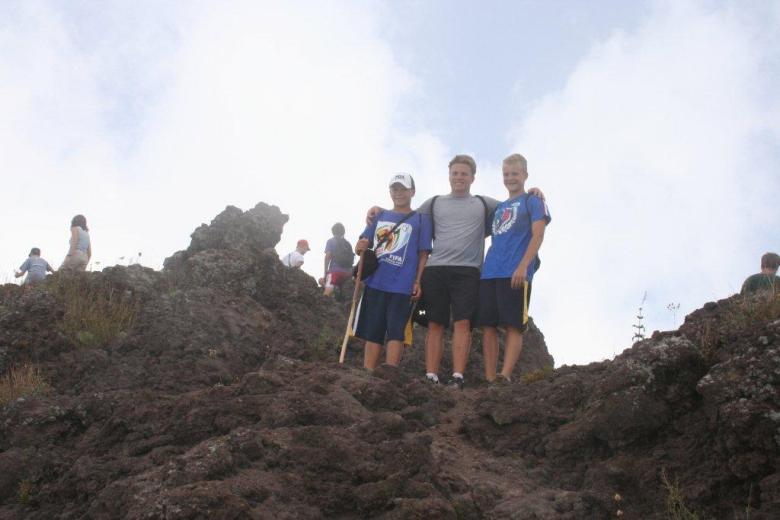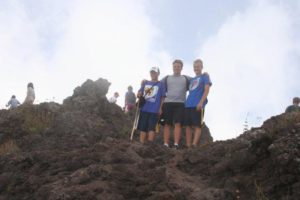DAY EIGHT — Climbing a Mountain!
Up, up the steep gravel path. It’s hot but we’re smiling.
It’s only a half mile but a steep 40 per cent grade makes it seem much longer. After all the eating aboard the Disney Magic as we cruise the Med, we’re glad for the exercise as we head to one of the most famous volcano craters in the world. Mt. Vesuvius.
Mt. Vesuvius, which had been considered extinct and, in fact, was covered with vineyards and homes, erupted so quickly that it buried Pompeii –five miles away–and a nearby city, Herculaneum, in minutes in 79 AD. The “rain of fire” lasted for three days. More than 10,000 people died, their bodies buried beneath 30 feet of molten ash.
We can’t see much of the view because of the clouds but we do see wisps of smoke from the still-active volcano which has erupted some 50 times since Pompeii was buried. Today two million people live in the immediate vicinity of Mount Vesuvius.
We peer into the crater. The teens climb up the gigantic black lava rocks and pose for pictures.
There are many shore excursions aboard the Disney Magic that are geared for adults and those traveling with teens and twenty-somethings, as well as those for younger kid with special youth activities.
We’ve chosen well for ourselves and the two 14 year old boys we’re traveling with. Not only do we hike up to the crater but we’re treated to lunch and wine tasting (the teens too) at the Cantina del Vesuvia, where the grapes on the vines look too perfect to be real. We eat on a covered patio overlooking the vineyards and feast on local foods: salami, , cheese, bread and olive oil and the most delicious pasta made with fresh tomatoes grown here at the vineyard. They boys make a new friend with 16 year old Ryan Blake from England who is a on his seventh Disney Cruise and opt for their own table.
We go for a stroll in the vineyard with owner Maurizio Russo and can’t resist purchasing some of the excellent wine and olive oil.
On to Pompeii after lunch. We’re standing in a dusty square trying to conjure up an image of a bustling gathering place with white marble floors, gleaming columns and fashionable people buying and selling wine, beautiful fabrics and exotic treasures — imagine SoHo in New York. Powerful politicians work just across the way. In our imaginations, there are gorgeous bronze statues everywhere. In reality, all that’s left are a few crumbling columns.
Welcome to Pompeii. The scene we’re trying to visualize would have taken place before 79 AD when the city, was a prosperous community known for its wine.
It’s never easy making an historic site interesting for kids and casts of human bodies aside, Pompeii is no different. The original Roman streets are uneven. There’s no multimedia presentation, no snack shop in the ancient city, no place to buy a drink — just a guide droning on. Still, I wouldn’t have missed showing this place to the teens for anything.
During our tour, we saw plaster casts of some of the bodies archeologists found. The kids, of course, loved the casts. It was hard to tear them away
The big stones in the middle of the street are stepping-stones so Pompeii’s citizens could avoid the water that flooded the roads when it rained. Chariots, apparently, were wide enough to pass over the stepping-stones.
Kids may not exactly appreciate what they’re seeing – an entire ancient civilization preserved in volcanic ash, a site that’s been excavated for 250 years and continues to be excavated today. Archaeologists have extricated many objects from the ash — jewelry, bakery ovens, even paintings. They’ve also unearthed public baths, stadiums where gladiators fought and lived, wine shops with tasting rooms and stacks of ancient wine jugs, even a mall with small shops and paintings of fish and chickens.
Not a trip—especially in the heat—for little ones who had some kid-specific excursions. The Adventures by Disney crew, for example, visited a farm in Sorrento where they made pizza and then headed to Capri.
Our guide explains that Pompeii was accidentally uncovered by workmen in 1748 who were building an aqueduct. We tour a house with original frescoes on the wall, a bakery, a fast food restaurant, see a campaign slogan on another wall and market signs–a lobster, a bread, a fish for those who couldn’t read. We see the huge amphitheater built in 70 AD that is the oldest and most complete pre-Coliseum style amphitheatre in the Roman world.
It is hot but oh so amazing. We skip the famous brothel with its erotic paintings, I’m told, because of the kids in the group.
By the end of the tour, everyone is sweaty and tired but no one is complaining. Gelato never tasted so good.


